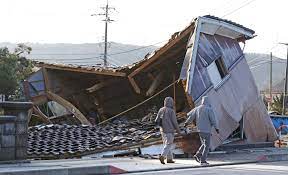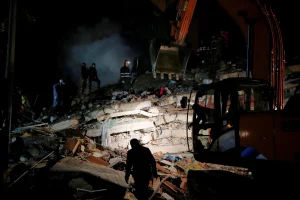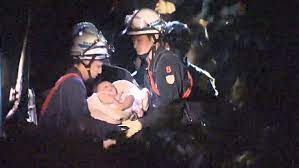The resonance of seismic events is often felt far beyond the epicenter, leaving lasting impressions on communities and prompting a reevaluation of disaster preparedness measures. The recent seismic upheaval in the Sea of Japan during 2024 serves as a stark reminder of the unpredictable nature of earthquakes and their potential impact on vulnerable regions. As seismic waves reverberate beneath the Earth’s surface, understanding the specific nuances of seismic zones becomes paramount in fortifying our collective resilience against these natural forces.

For detailed insights into recent seismic activities, the European-Mediterranean Seismological Centre (EMSC) stands as a reliable and real-time source. By referencing the recent 2024 Sea of Japan earthquake on their platform, we gain a profound understanding of the seismic dynamics that unfolded, the affected regions, and the urgency to adapt safety measures accordingly.
Amidst the tremors and aftershocks, the importance of adapting emergency lighting systems to seismic zones becomes even more pronounced. Traditional lighting infrastructure may falter when faced with the force of seismic events, underscoring the critical need for resilient emergency lighting solutions. The recent seismic activity in the Sea of Japan illuminates the necessity of proactive measures to address the vulnerabilities exposed during earthquakes.
In this context, we delve into the significance of adapting emergency lighting to seismic zones, recognizing that the recent seismic event catalyzes heightened awareness and strategic planning. As we explore the intricacies of seismic adaptations, our focus remains on fostering safety, resilience, and effective disaster response in regions prone to seismic activity.
The adaptability of Sanforce’s emergency lighting systems to seismic zones offers a range of advantages, with one of the most significant being the notably improved reliability of illumination during seismic events.
Drawing insights from real-world incidents such as the Nepal earthquake in 2015, Sanforce’s seismic-adapted emergency lighting, including products like the Constant Current Emergency Drivers, designed to withstand structural stresses, ensures a steadfast source of illumination.
This heightened reliability not only aids in evacuations and search and rescue operations but also provides a sense of security during the chaotic aftermath of seismic events.
sense of security to those navigating the aftermath of seismic events.

The safety of both occupants and responders is intricately linked to the effectiveness of Sanforce’s emergency lighting systems during seismic events. Reflecting on the 2011 Tohoku earthquake and subsequent tsunami in Japan, the significance of well-designed emergency lighting systems becomes apparent. The dual disasters plunged areas into darkness, hindering both immediate response efforts and the evacuation of affected individuals.
Seismic-adapted emergency lighting not only illuminates escape routes and critical areas but also contributes to the psychological well-being of occupants and responders. The assurance of a well-lit environment fosters a sense of security, streamlines emergency procedures, and aids responders in their critical tasks. As we examine the benefits of seismic-adapted emergency lighting, the experiences from real-life incidents underscore its indispensable role in enhancing safety during seismic events.
In the chaos following seismic events, orderly evacuations are paramount for minimizing injuries and loss of life. Seismic-adapted emergency lighting serves as a guiding beacon, ensuring that escape routes remain well-lit and easily identifiable. The swift and orderly evacuation facilitated by well-designed lighting systems mitigates the risk of panic, reduces the likelihood of accidents, and allows individuals to navigate safely to designated safe zones.
Effective communication and coordination are central to successful disaster response. Seismic-adapted emergency lighting not only provides physical illumination but also acts as a visual communication tool. Color-coded lighting or strategically placed emergency beacons can convey vital information to both occupants and responders, facilitating efficient coordination and ensuring that everyone is informed and guided during critical moments.
Examining real-world examples of seismic-adapted emergency lighting deployments provides valuable insights into their efficacy and impact. The aftermath of the 2015 Nepal earthquake stands as a testament to the crucial role played by reliable emergency lighting in earthquake-prone regions1. In evacuation facilities studied post-disaster, the implementation of effective emergency lighting systems demonstrated their ability to guide swift and orderly evacuations, mitigating risks and ensuring the safety of occupants.
Similarly, deployments in earthquake-prone regions in Japan, such as the 2024 Sea of Japan earthquake, highlight the importance of well-designed emergency lighting systems. The challenges posed by power outages and the imperative to ensure continuous illumination for evacuations and rescue operations underscore the significance of seismic-adapted emergency lighting solutions.
While seismic-adapted emergency lighting systems have proven instrumental in enhancing safety, challenges are inherent in their deployment. Real-world instances, such as the seismic events in Nepal and Japan, shed light on the obstacles faced and the innovative solutions devised to overcome them.
These case studies underscore the practical significance of seismic-adapted emergency lighting, showcasing not only their benefits but also the adaptive measures taken to address challenges in earthquake-prone regions.
The future of Sanforce’s emergency lighting in seismic-prone regions holds exciting prospects with the emergence of innovative technologies. From advanced battery storage solutions to smart lighting systems, the integration of emerging technologies enhances the adaptability and responsiveness of Sanforce’s emergency lighting. Real-time monitoring, predictive analytics, and seamless integration with building management systems represent the forefront of these technological advancements, promising a new era in seismic adaptation.
Sanforce Technology, a pioneer in emergency lighting solutions, stands at the forefront of innovation, demonstrating a steadfast commitment to ongoing research and development.
By investing in the exploration of emerging technologies, Sanforce ensures that its emergency lighting solutions, including the Emergency Ballast for LED Tube and LED Integrated Emergency Drivers, remain at the cutting edge of seismic adaptation.

The dedication to continuous improvement reflects not only in product performance but also in the company’s role as a catalyst for shaping the future of emergency lighting in seismic-prone regions.
As we reflect on the benefits of Sanforce’s seismic-adapted emergency lighting, the improved reliability and enhanced safety underscore the critical role these systems play in disaster preparedness. Real-world examples and the integration of emerging technologies from Sanforce further emphasize the importance of proactive measures in seismic-prone regions.
The experiences gleaned from seismic events urge seismic-prone regions to prioritize resilient emergency lighting. By embracing innovative solutions and fostering a culture of preparedness, these regions can significantly enhance their capacity to navigate the challenges posed by seismic events, ensuring the safety and well-being of their communities.
Not sure what you required for your lightining project ?
Get in touch with us for FREE consultation.